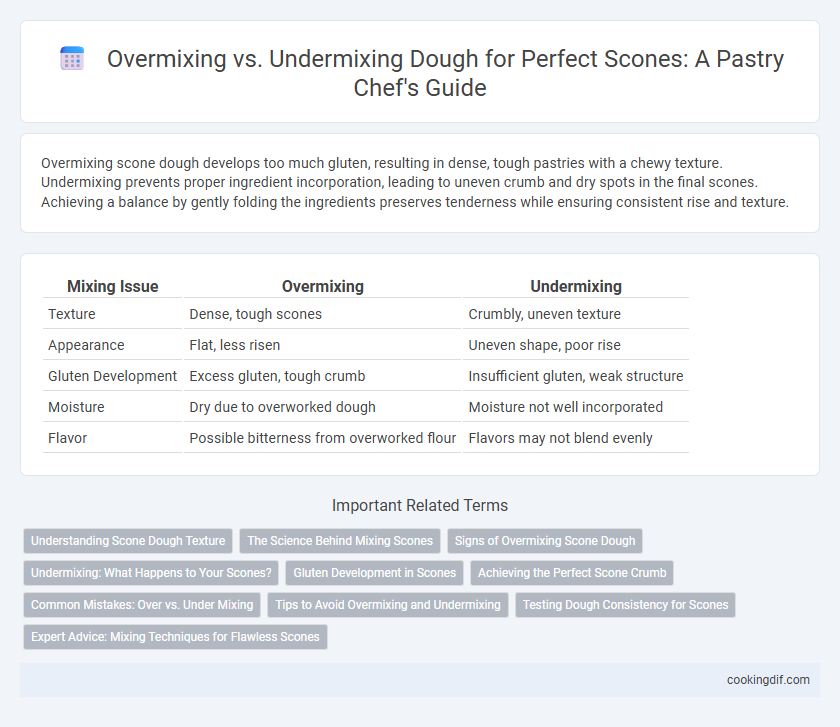Overmixing scone dough develops too much gluten, resulting in dense, tough pastries with a chewy texture. Undermixing prevents proper ingredient incorporation, leading to uneven crumb and dry spots in the final scones. Achieving a balance by gently folding the ingredients preserves tenderness while ensuring consistent rise and texture.
Table of Comparison
| Mixing Issue | Overmixing | Undermixing |
|---|---|---|
| Texture | Dense, tough scones | Crumbly, uneven texture |
| Appearance | Flat, less risen | Uneven shape, poor rise |
| Gluten Development | Excess gluten, tough crumb | Insufficient gluten, weak structure |
| Moisture | Dry due to overworked dough | Moisture not well incorporated |
| Flavor | Possible bitterness from overworked flour | Flavors may not blend evenly |
Understanding Scone Dough Texture
Scone dough texture relies on balancing mixing to avoid overmixing, which develops excess gluten leading to tough, dense scones, and undermixing, which causes uneven ingredient distribution resulting in crumbly, dry pastries. Ideal scone dough should be softly cohesive with visible butter chunks to create a flaky texture and tender crumb. Achieving this optimal texture enhances rise and tenderness, crucial for classic, light scones.
The Science Behind Mixing Scones
Overmixing scone dough activates excess gluten development, resulting in tough, dense pastries rather than tender, crumbly textures. Undermixing prevents proper hydration and distribution of fat, causing uneven crumb structure and dry patches within the scone. Achieving the optimal mix preserves delicate gluten strands while evenly incorporating fat, ensuring light, flaky layers characteristic of classic scones.
Signs of Overmixing Scone Dough
Overmixing scone dough leads to tough, dense texture and visible streaks of gluten development in the dough. The dough loses its tender, flaky quality and may have a shiny, overly wet appearance with large, irregular holes after baking. Signs include heavy, rubbery scones with uneven rise and a chewy crumb instead of the desired light and crumbly consistency.
Undermixing: What Happens to Your Scones?
Undermixing scone dough results in unevenly distributed ingredients, leading to dense, crumbly texture rather than a tender, flaky crumb. Large pockets of dry flour can remain, causing scones to fall apart and lack desired rise during baking. Properly blending just until combined ensures even hydration and optimal gluten development for light, fluffy scones.
Gluten Development in Scones
Overmixing scone dough excessively activates gluten strands, resulting in tough, dense scones rather than light, tender ones. Undermixing, however, leaves the dough too crumbly and prevents proper gluten network formation, leading to scones that may crumble and lack structure. Achieving the perfect balance in mixing controls gluten development, producing scones with an ideal crumb and flaky texture.
Achieving the Perfect Scone Crumb
Achieving the perfect scone crumb depends on balancing mixing techniques: overmixing develops gluten, resulting in dense, tough scones, while undermixing leaves flour pockets and uneven texture. Properly mixing until just combined ensures tender, flaky layers with a light, crumbly interior. Incorporating cold butter and minimal handling preserves optimal flakiness for bakery-quality scones.
Common Mistakes: Over vs. Under Mixing
Overmixing scone dough causes excessive gluten development, resulting in tough, dense pastries rather than light, flaky scones. Undermixing leaves ingredients unevenly incorporated, leading to crumbly texture and inconsistent rise. Achieving the right balance ensures tender, fluffy scones with a perfect crumb and optimal rise.
Tips to Avoid Overmixing and Undermixing
To achieve perfectly tender scones, avoid overmixing the dough by gently folding ingredients until just combined, preserving the delicate crumb structure. Prevent undermixing by ensuring all dry ingredients are evenly incorporated and the dough holds together without visible streaks of flour. Use a light hand and minimal stirring to balance gluten development, resulting in flaky, soft scones with a golden crust.
Testing Dough Consistency for Scones
Testing dough consistency for scones involves balancing moisture and texture to avoid overmixing or undermixing. Overmixing scone dough can develop excess gluten, resulting in tough, dense pastries, while undermixing leaves uneven flour pockets causing dry or crumbly scones. Ideal dough should appear shaggy and slightly sticky, ensuring tender, flaky scones with a light crumb.
Expert Advice: Mixing Techniques for Flawless Scones
Overmixing scone dough develops excess gluten, resulting in dense, tough textures rather than tender, flaky layers. Undermixing leaves pockets of dry ingredients and uneven leavening, causing inconsistent rise and crumb. Expert bakers recommend gently folding ingredients just until combined to achieve the ideal balance for flawless, crumbly scones.
Overmixing vs undermixing for scones Infographic

 cookingdif.com
cookingdif.com